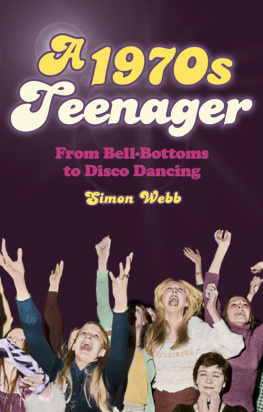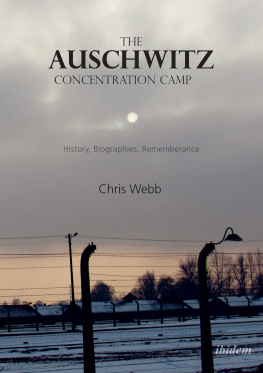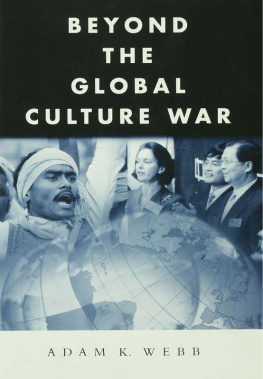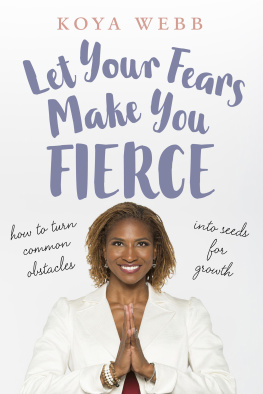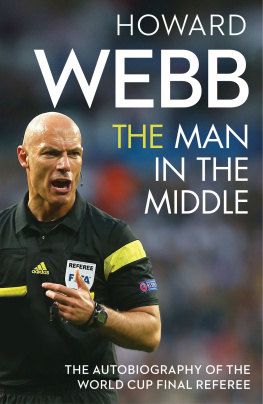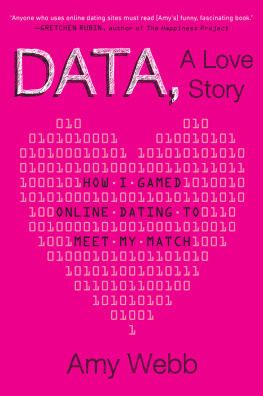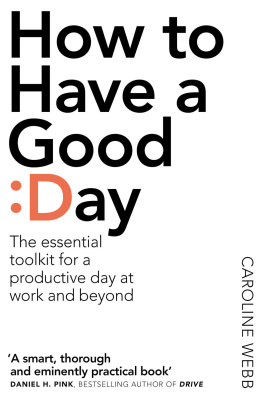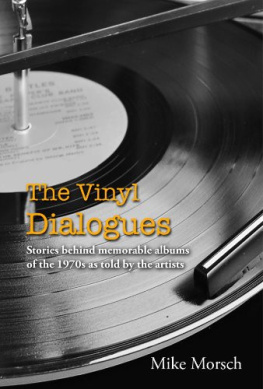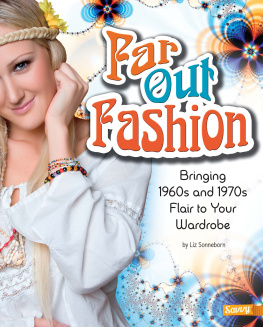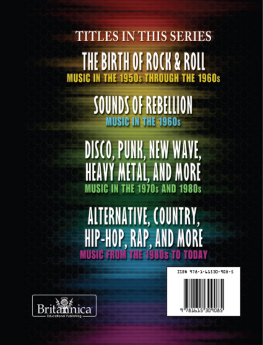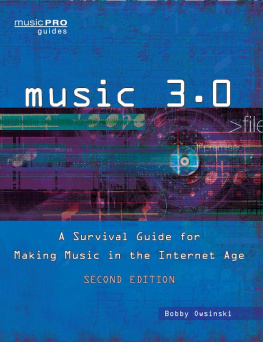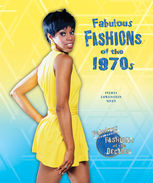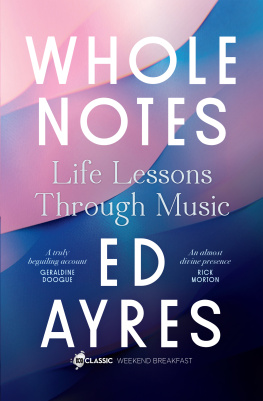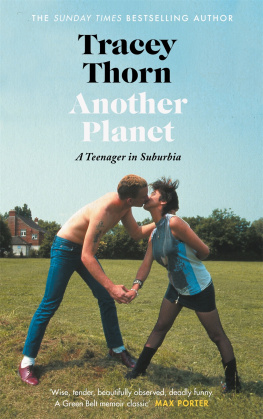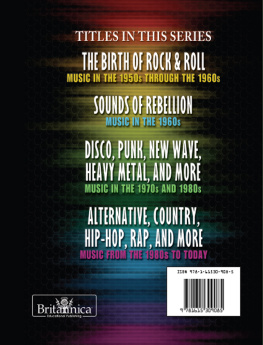
Thank you to the following people: Chris Arthur, Terry Barlow, Mary A. Barker, Paul Clarke, Katherine Cassidy, Geoffrey C. Feldman, David Ford, Esther M. Hannigan, Pat Howard, Theresa O. Littlestone, Gillian V. Pettitt, Sarah P. Moran, Martin OConnell, Mick Parker, Polly Reynolds, K.A. Silverstone, Maria T. Valentine, Christopher Walker, and Nina Webb.
Contents
.
.
.
.
.
.
.
.
.
.
.
.
.
.
.
.
For those who were teenagers then, the 1970s must surely have been the most exciting decade there has ever been. It is fashionable now to be dismissive about many of the visual features of those years, dismissing it as The decade style forgot, but at the time it all seemed so fantastically vibrant and colourful. This book is a celebration of the 1970s; the good, the bad and ugly. There was, after all, more to those times than just Abigails Party , the Bay City Rollers , platform shoes, and flared trousers.
I do not believe that there has ever been a better time to be a teenager than the seventies! It was brash and noisy, the fashions were ghastly, but it was all tremendous fun. Our music was being heard everywhere, those of us who were working always seemed to have plenty of money and the atmosphere of crisis which permeated the whole decade served only to make it seem richer and more exotic. The various strikes and riots, the IRA attacks on the mainland, the Winter of Discontent and Thatcher being elected; even at the time I knew that we were living through a momentous period of change. (Polly Reynolds)
Although they could not have fully known it at the time, teenagers of the 1970 s were growing to maturity on the very cusp of the transition from the post-war years to the modern world. This was when the twentieth century began to gear up and ready itself for the change to the twenty-first century. At the beginning of the decade, the technology in use had changed little since the end of Queen Victorias reign; slide rules, mechanical typewriters, telephones, clockwork watches and even gramophones were still in use. By 1979 , the electronic revolution had begun and there were digital watches, pocket calculators, Walkmans and even the first personal computers.
I was born in 1960 and the changes that I saw taking place during my teenage years, from 1973 -, were absolutely dizzying. It was like watching the birth of the modern world. Every year there was something new. I remember seeing a video recorder in somebodys house for the first time, using a push button telephone instead of one with a dial, my first digital watch, and computer games in amusement arcades and pubs. Although at that age you dont recognise the full significance of what you are seeing, I realised that the world was changing very fast. (Paul Clarke)
Teenagers who grew up over the course of the 1970 s were witness to these changes. A thirteen-year-old attending school in 1970 would have been using a slide rule; by the time he was twenty he would probably have had a pocket calculator. In 1970 , most televisions were black and white; by 1980 , not only were colour televisions more commonplace, but one could even record programmes to watch later. Computer games like Space Invaders were also making an appearance at this time. Those whose teenage years spanned the 1970 s saw more changes taking place than any other generation since the Industrial Revolution.
Of course, young people adapt much more easily to change than old people. There was so much happening in the seventies, from the end of pounds, shillings and pence in 1971 , to the first woman Prime Minister in 1979 . I know my parents felt a little bewildered at the pace of change and my grandparents could not keep track of things at all. Because I was a teenager I had nothing to compare it to, but my parents had seen slow and steady changes and gradual development from the twenties through to the sixties. Suddenly, the pace accelerated and things were changing faster and faster. You had no sooner seen about computer games or portable calculators on Tomorrows World , than they were in the shops or peoples homes. It was a great time to be young! (Terry Barlow)
The term teenager was not an invention of the 1970 s; the expression dates back to the late 1940 s. Pop music had been around since the 1950 s and so too had various other features of 1970 s teenage life. However, the fads, fashions and foibles of teenagers changed during those years from being footnotes in the news to becoming a dominant force in British culture. This was when the cult of youth began in this country and being young, or at least behaving as though one were young, became, for some, something to covet.
When I was a kid in the sixties, my father even used to wear a collar and tie on the beach. By the time the eighties arrived, he was wearing jeans at the weekend. I could see that people his age were becoming more informal in their dress and it struck me then that it was because they were becoming a little wistful that they were not themselves young any more. Of course, I do exactly the same thing myself today, sharing clothes with my younger daughter. I suppose it would be fair to say that at the age of fifty, I dont want to grow up myself. (Anon)
The technology at the start of the 1970 s had, essentially, remained unchanged for many decades and so too had the way that the average person dressed. At the end of the 1960 s, only a teenager or person in their early twenties would have worn a pair of blue jeans in public; by 1980 , even middle-aged men were wearing jeans and leaving their shirts unbuttoned. Photographs of families relaxing on the beach in the 1950 s and s show men wearing sports jackets and even collars and ties. This would have been unthinkable by the 1980 s. The 1970 s saw a relaxation of the dress codes that had held sway since the end of the First World War. It was the decade when everybody wanted to appear young; when being a teenager was suddenly an admirable ambition, even for men and women in their forties.
It was pretty embarrassing when my parents decided to become more with it, as they would have put it. Something that you always notice about parents when they try to act young is that their use of slang is often a bit out of style. Beatniks in the fifties might have been with it, but to hear my father using the phrase in the late seventies was a little bit of an anachronism. Anyway, they began to listen to music like ABBA and take an interest in what young people were doing and saying. I think now that they felt that teenagers were having all the fun and so they should get into the swing of things. I noticed in the pub at that time that you would see more and more middle-aged men hoping to look young and with it. (David Ford)
The division between the various stages in life definitely began to become blurred for the first time during the late seventies. Before that, you were a schoolchild, then a young man or woman, followed by becoming middle aged and then old. At each stage in the process, there were accepted styles of dress, clothing, hairstyle and behaviour. For example, middle-aged women had their hair permed, rather than hanging long and loose. Old women had white hair, also permed. Young men might wear more casual clothes, but right up to the beginning of the seventies, middle-aged men were expected to be a bit more conservative. By the time you were an old man, which happened in those days at about the age of sixty, you would be wearing a collar and tie, even on a picnic! All this faded away as the seventies progressed.
Older women were allowing their hair to be long and natural, middle-aged men were wearing jeans and open-necked shirts; the divisions between the ages were breaking down and older people wanted to look as much like teenagers as they dared; not all of them, of course, but it was certainly a noticeable trend. (Polly Reynolds)
Next page
